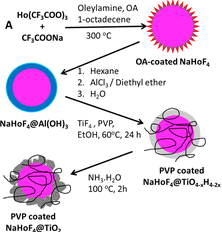NanoFASE Pristine Particle: Holmium-labelled TiO2 ENMs
The goal here was to make titanium dioxide (TiO2) ENMs that could be tracked in the environment against a high background of naturally abundant Ti. NanoFASE partners EAWAG and UoB determined that to have sufficient resolution of the chemically labelled ENMs, at least 10% of the Ti atoms would have to be replaced by holmium (Ho). However, this would introduce too great a change in the lattice structure and properties of the TixHo1-xO2 ENMs compared to those of the TiO2 particles whose environmental fate and behaviour they were supposed to represent. To overcome this, an alternative strategy was developed, whereby all of the Ho was made as a core, and a layer of TiO2 was grown around this, such that the TiO2 layer would be representative of the unlabelled TiO2 ENMs, while the Ho core would serve as a tracer for the ENMs. Core shell particles are represented notationally as Ho@TiO2 core–shell ENMs.
This synthesis approach proved to be a lot harder than expected, and numerous routes were tried with varied degrees of success. The outcome solution for producing the core-shell particles involved a templating method for the large-scale synthesis of NaHoF4@TiO2 core–shell ENMs, in which a sacrificial Al(OH)3 layer was deposited onto the NaHoF4 core ENM surface and then etched by HF or other fluorinated species via the hydrolysis of TiF4, resulting in the outer TiO2 shell. The resulting ENMs consisted of a 60 nm NaHoF4 core and a 5 nm anatase TiO2 shell, as determined by TEM, STEM-EDX mapping, and spICP-MS.

Figure: A schematic illustration of the synthetic route to produce NaHoF4@TiO2 ENMs. From Cui et al., 2019.
Read more |
|
Cui X, Fryer B, Zhou D, Lodge R, Khlobystov A, Valsami-Jones E, Lynch I. Core-shell NaHoF4@TiO2 NPs: A Labelling Method to Trace Engineered Nanomaterials of Ubiquitous Elements in The Environment. ACS Applied Materials & Interfaces, 2019, 11, 19452-19461. https://pubs.acs.org/doi/10.1021/acsami.9b03062 |
Contact

Xianjin Cui
 Iseult Lynch
Iseult Lynch
University of Birmingham
